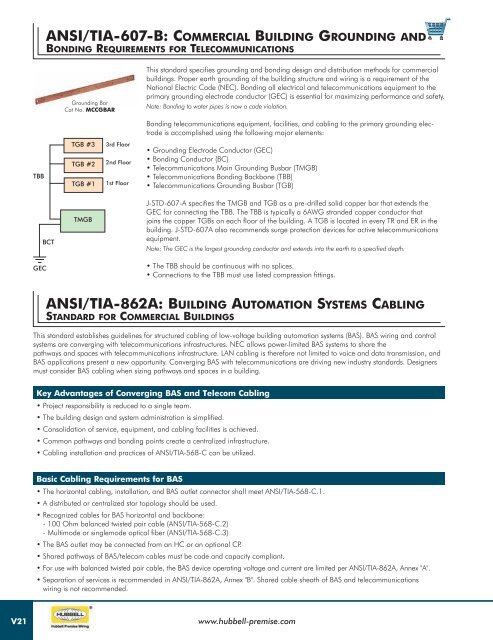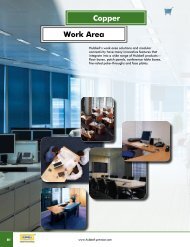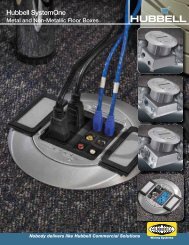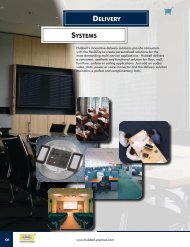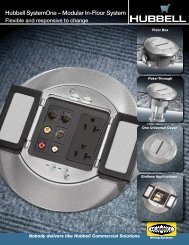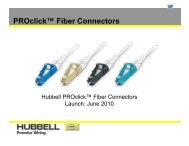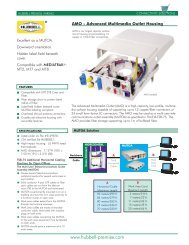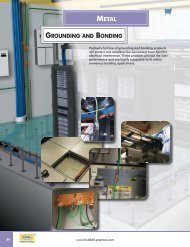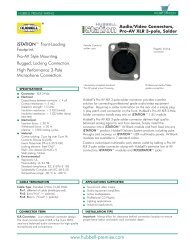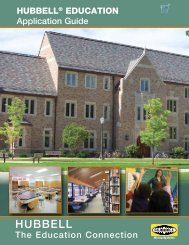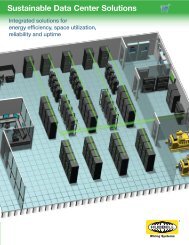ANSI / TIA -568-C - Hubbell Premise Wiring
ANSI / TIA -568-C - Hubbell Premise Wiring
ANSI / TIA -568-C - Hubbell Premise Wiring
Create successful ePaper yourself
Turn your PDF publications into a flip-book with our unique Google optimized e-Paper software.
<strong>ANSI</strong>/<strong>TIA</strong>-607-B: Commercial Building Grounding and<br />
Bonding Requirements for Telecommunications<br />
Grounding Bar<br />
Cat No. MCCGBAR<br />
This standard specifies grounding and bonding design and distribution methods for commercial<br />
buildings. Proper earth grounding of the building structure and wiring is a requirement of the<br />
National Electric Code (NEC). Bonding all electrical and telecommunications equipment to the<br />
primary grounding electrode conductor (GEC) is essential for maximizing performance and safety.<br />
Note: Bonding to water pipes is now a code violation.<br />
Bonding telecommunications equipment, facilities, and cabling to the primary grounding electrode<br />
is accomplished using the following major elements:<br />
TBB<br />
TGB #3<br />
TGB #2<br />
TGB #1<br />
3rd Floor<br />
2nd Floor<br />
1st Floor<br />
• Grounding Electrode Conductor (GEC)<br />
• Bonding Conductor (BC)<br />
• Telecommunications Main Grounding Busbar (TMGB)<br />
• Telecommunications Bonding Backbone (TBB)<br />
• Telecommunications Grounding Busbar (TGB)<br />
BCT<br />
TMGB<br />
J-STD-607-A specifies the TMGB and TGB as a pre-drilled solid copper bar that extends the<br />
GEC for connecting the TBB. The TBB is typically a 6AWG stranded copper conductor that<br />
joins the copper TGBs on each floor of the building. A TGB is located in every TR and ER in the<br />
building. J-STD-607A also recommends surge protection devices for active telecommunications<br />
equipment.<br />
Note: The GEC is the largest grounding conductor and extends into the earth to a specified depth.<br />
GEC<br />
• The TBB should be continuous with no splices.<br />
• Connections to the TBB must use listed compression fittings.<br />
<strong>ANSI</strong>/<strong>TIA</strong>-862A: Building Automation Systems Cabling<br />
Standard for Commercial Buildings<br />
This standard establishes guidelines for structured cabling of low-voltage building automation systems (BAS). BAS wiring and control<br />
systems are converging with telecommunications infrastructures. NEC allows power-limited BAS systems to share the<br />
pathways and spaces with telecommunications infrastructure. LAN cabling is therefore not limited to voice and data transmission, and<br />
BAS applications present a new opportunity. Converging BAS with telecommunications are driving new industry standards. Designers<br />
must consider BAS cabling when sizing pathways and spaces in a building.<br />
Key Advantages of Converging BAS and Telecom Cabling<br />
• Project responsibility is reduced to a single team.<br />
• The building design and system administration is simplified.<br />
• Consolidation of service, equipment, and cabling facilities is achieved.<br />
• Common pathways and bonding points create a centralized infrastructure.<br />
• Cabling installation and practices of <strong>ANSI</strong>/<strong>TIA</strong>-<strong>568</strong>-C can be utilized.<br />
Basic Cabling Requirements for BAS<br />
• The horizontal cabling, installation, and BAS outlet connector shall meet <strong>ANSI</strong>/<strong>TIA</strong>-<strong>568</strong>-C.1.<br />
• A distributed or centralized star topology should be used.<br />
• Recognized cables for BAS horizontal and backbone:<br />
- 100 Ohm balanced twisted pair cable (<strong>ANSI</strong>/<strong>TIA</strong>-<strong>568</strong>-C.2)<br />
- Multimode or singlemode optical fiber (<strong>ANSI</strong>/<strong>TIA</strong>-<strong>568</strong>-C.3)<br />
• The BAS outlet may be connected from an HC or an optional CP.<br />
• Shared pathways of BAS/telecom cables must be code and capacity compliant.<br />
• For use with balanced twisted pair cable, the BAS device operating voltage and current are limited per <strong>ANSI</strong>/<strong>TIA</strong>-862A, Annex "A".<br />
• Separation of services is recommended in <strong>ANSI</strong>/<strong>TIA</strong>-862A, Annex "B". Shared cable sheath of BAS and telecommunications<br />
wiring is not recommended.<br />
V21<br />
www.hubbell-premise.com


